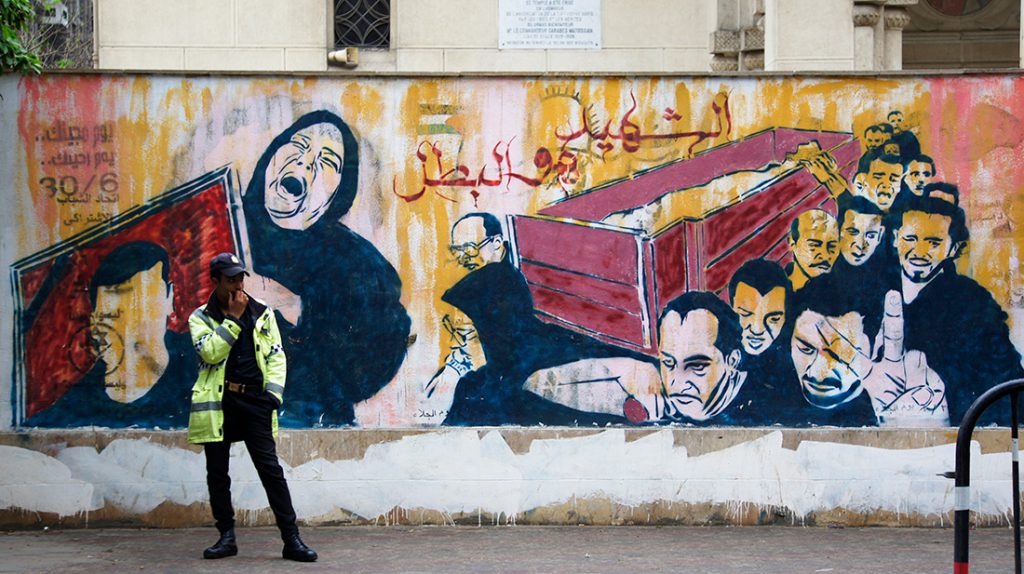
Political Tribalism and Violent Extremism

An Egyptian police officer keeps watch over a church in downtown Cairo in front of a mural that reads, "The martyr is the hero." In the years following Egypt's January 25th revolution, thousands of protestors have been killed by security forces across the country, mainly in the capital.
by Dallin Van Leuven (Honors ’10)
photo by Dallin Van Leuven
As a peacebuilder and researcher of violent extremism, I study how conflicts develop and what can be done to prevent them. Violent extremism, often mystified as a “phenomenon,” is simply another form of violent conflict—complete with allies (noble and above repute), enemies (evil and targets for elimination), a cause, tactics, and an objective. As with any other conflict, violent extremism shapes and twists each of these elements into grotesques of reality. Violent extremism feeds on tribalism—not tribalism in the traditional sense, mind you, but in its toxic, political sense. In this iteration, a person is unflinchingly loyal to their political group and fiercely hostile to another. Even those simply suspected of being of another “tribe” can be targeted in these toxic environments.
The first time I truly encountered toxic tribalism was in Egypt in 2013, in the days following Mohamed Morsi’s ouster from the presidency. Then, the tide had turned so far against Morsi’s Muslim Brotherhood that any man wearing a beard could be accused of being with them. An Egyptian friend of mine intentionally grew out his beard to spark conversations to counter what he called the “racism” he saw. What was once Egypt’s strongest political party has now been deemed a terrorist organization, and anyone expressing sympathy for the group—or even opposition to the current government—is accused of supporting terrorism.
Through my research on radicalization in the Lebanese city of Tripoli, where Sunnis and Alawites violently clashed for years over their respective support or opposition to the neighboring Syrian president Bashar al-Assad and his government, I learned how young Sunni men would face harassment at military checkpoints throughout the city. They told us of their coping strategies, such as shaving their beards, downloading Shi’a songs on their phones, or even carrying beer (a taboo in Islam) when they crossed the checkpoints in order to not be swept up or accused of being an extremist. Alawite parents, on the other hand, were giving their children Christian names to help them avoid prejudice later in life. For both groups, these dynamics fed a sense of marginalization and of not belonging and—for a few—led them to join armed or even violent extremist groups to fight in Syria.
But how do these dynamics play out in our own countries, states, and communities? The United States is certainly not safe from them. After over five years in the Middle East and North Africa, I am becoming increasingly surprised at how the playbooks I saw there are being used back home. Groups such as white supremacists and neo-Nazis are adeptly trying to poison the debate around national issues and reframe them into ones that promote tribalism and violent extremism. For example, according to the leaked style guide of the neo-Nazi website, The Daily Stormer, articles submitted for publication there should turn even mundane political issues into the beginning salvo of the supposedly impending “white genocide.” “All enemies should be combined into one enemy, which is the Jews,” the site’s Andrew Anglin allegedly writes. “There should be a conscious agenda to dehumanize the enemy, to the point where people are ready to laugh at their deaths.”
For these violent extremist efforts to succeed, they must be introduced into the mainstream political discourse. This may be done with willing coconspirators, but it often creeps into society through tribalism. Since violent extremism (in all its varieties) so often seeks the elimination of other ethnic/religious/class/political groups, tribalism can shape the environment in ways that increase divisions, foment hatred, and allow violent extremism to gain a foothold in society. To be resilient to the threat of violent extremism, we must reject tribalism and see past the superficial markings of those we might seek to assign to another “tribe”—whether it be the color of their skin, a Make America Great Again hat, a badge, their religious clothing, or their country of origin (just to list a few). We must find the nuance and compromise in every issue and resist the urge to dismiss worldviews that are not our own.
We can prevent tribalism by being conscious of its objectives, and we can check ourselves by asking the questions I often use when studying violent extremism:
How are different sides of an issue representing themselves, the other side, and outside
groups?
What are the ways in which the different sides shape, reframe, or propagate falsehoods
about the issues in ways that drive tribalism?
By being conscious of our own biases and understanding how issues are distorted and used to drive tribalism or even violent extremism, we can find ways to reject these currents in our own lives as well as in our communities.
Dallin Van Leuven (Honors ’10) is a specialist in countering violent extremism who works for the nonprofit peacebuilding organization Search for Common Ground. He received his BS in justice studies from Westminster before earning an MA in law and diplomacy from The Fletcher School. Van sits on the board of directors for the Center for Progressive Security and currently resides in Rome, Italy.
About the Westminster Review
The Westminster Review is Westminster University’s bi-annual alumni magazine that is distributed to alumni and community members. Each issue aims to keep alumni updated on campus current events and highlights the accomplishments of current students, professors, and Westminster alum.
GET THE REVIEW IN PRINT Share Your Story Idea READ MORE WESTMINSTER STORIES